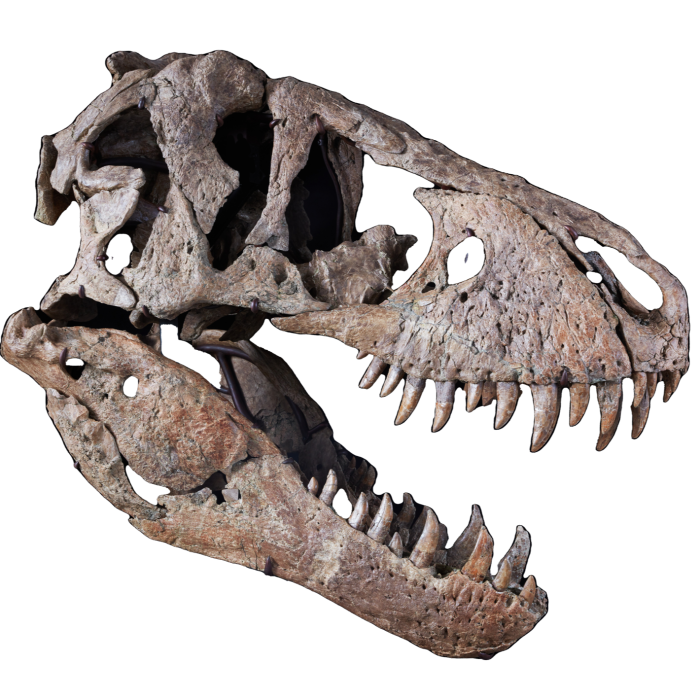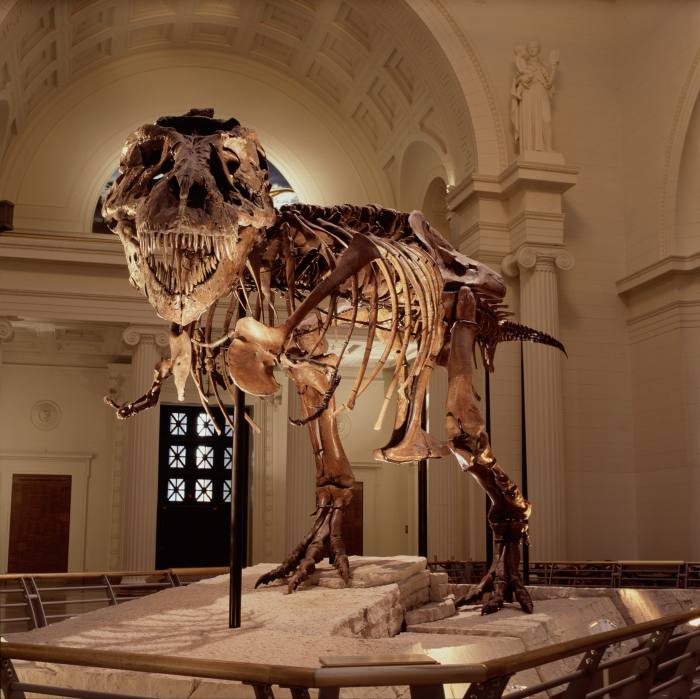On 18 April, TRX-293 Trinity, a 67mn-year-old Tyrannosaurus rex skeleton, will go on sale at Koller Auctions in Zurich. With a reserve of SFr5mn-SFr8mn (about £4.4mn-£7.1mn), it will be the first “complete” T-rex to go on sale in Europe, and only the third in the world. Given that the record price for a T-rex at auction is for “Stan” – which sold for $31.8mn in 2020 – that reserve may be somewhat conservative. It is a composite of three T-rexes excavated from the Hell Creek and Lance Creek formations in Montana and Wyoming, where Stan came from, and “Sue”, which sold at auction for $8.4mn in 1997. Whatever Trinity fetches, the prices suggest that dinosaurs have entered the realm usually reserved for the most highly prized works of art. Nicolas Cage and Leonardo DiCaprio are known to have bid against one another for the skull of a Tarbosaurus bataar. Tech companies in Silicon Valley are vying for prehistoric relics to enliven their art-laden lobbies.

Last year, two of London’s prominent high art festivals, Frieze Masters and Masterpiece, featured dinosaur fossils, an adult triceratops skull (sold for “a six-figure sum”), a juvenile triceratops skull on sale for £650,000 and the skeleton of a camptosaurus with a list price of £1mn. David Aaron Gallery was responsible for these fossils. Currently on display at its Mayfair showroom is its juvenile triceratops skull. The gallery was established in 1910 and is managed by the third and fourth generations of the Aaron family. “It was a natural transition to work with dinosaur fossils as our family business has generations of experience in dealing with antiquities and Islamic art,” says Benjamin Aaron. Along with the skull there is a large accompanying folder that documents every person, tool or material that has come into contact with the piece, why, and when. Then there are the expert testimonials, from scientists and industry experts. There are photos, graphs, drawings and videos about the provenance.


T-rex skull sold by Sotheby’s for $6.1mn in 2022

Triceratops skull, sold by David Aaron Gallery in 2022
How crucial it is to get the research right was evidenced by the planned sale at Christie’s in 2022 of a T-rex named “Shen”. The auction was called off days before the fossil was estimated to fetch up to $25mn, with a need for “further study” being cited. According to The New York Times, the sale fell apart when palaeontologist Peter Larson questioned how much of it was a replica.
There are also big ethical questions posed by the private sale of dinosaur fossils. Cassandra Hatton, global head of science and popular culture at Sotheby’s, explains that the majority of legally traded fossils originate on private land in the United States. Large ranches in the American Midwest, Wyoming, Montana and the Dakotas will have agreements with commercial palaeontologists. These palaeontologists – unlike academic palaeontologists in universities or museums – will split the profits with ranchers upon discovering, excavating and selling the fossils. Prof Steve Brusatte, chair of palaeontology and evolution at the University of Edinburgh says that teams are turning up one new dinosaur species per week through commercial digs.

Jack Horner, believed to be the inspiration for Dr Alan Grant in Jurassic Park, argues that the commercial fossil trade works against science. “Those of us who dig to advance science do so from universities and museums. The specimens we collect remain in the public trust where everyone has access to them. Commercial collectors dig to make a profit, and they usually don’t care where the specimen ends up.”

Where to buy
Christie’s, christies.com
David Aaron Gallery, davidaaron.com
Koller Auktionen, kollerauktionen.ch
Sotheby’s, sothebys.com
What to read
Dinosaurs: The Encyclopaedia by Donald F Glut (McFarland)
Tyrannosaurus Rex by Peter Larson and Kenneth Carpenter (Indiana University Press)
Where to see
Badlands Dinosaur Museum, Dickinson, North Dakota
Fernbank Museum of Natural History, Atlanta
Fukui Dinosaur Museum, Japan
Museum für Naturkunde, Berlin
The Natural History Museum, London; Titanosaur: Life as the Biggest Dinosaur is on display until 7 January 2024
Muséum National d’Histoire Naturelle, Paris
Royal Belgian Institute of Natural Science, Brussels
Wyoming Dinosaur Center, Wyoming
It’s almost impossible to find a collector who will speak openly on the subject. But one American entrepreneur, whose collection – which started modestly with a T-rex tooth – is now significant enough to feature in museum exhibitions, offers a counter view: “Do I feel bad about wanting to possess them? No, because that scientific curiosity is natural. But have you ever come across a collector who buys a fossil to keep it out of the hands of other people? I have not. For collectors like me, the need to share is bigger than the need to possess: most natural history museums were started by private collectors.”
Sue can be found at Chicago’s Field Museum, and Stan is heading to Abu Dhabi’s future Natural History Museum. Says Prof Paul Barrett, head of fossil vertebrates at the Natural History Museum in London: “Despite the polarising nature of the conversation, the reality is that most institutional fossil collections have been acquired from commercial collections. Without private paleontological activity we simply would not have specimens for our own research or to exhibit to the public. As always, there is a sensible middle ground.” Let’s hope TRX-293 Trinity will soon arrive in a gallery near you.
Stay connected with us on social media platform for instant update click here to join our Twitter, & Facebook
We are now on Telegram. Click here to join our channel (@TechiUpdate) and stay updated with the latest Technology headlines.
For all the latest Art-Culture News Click Here
